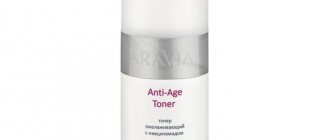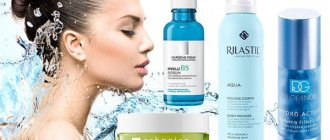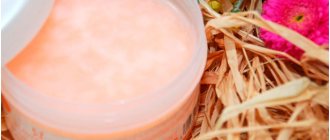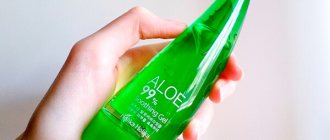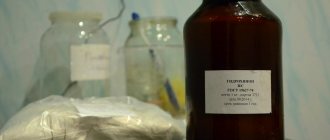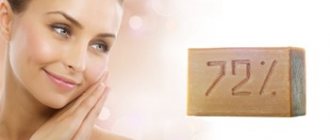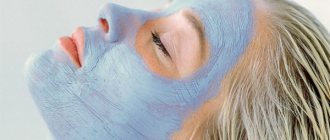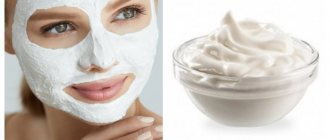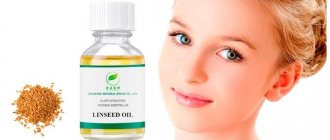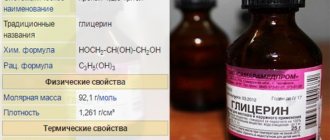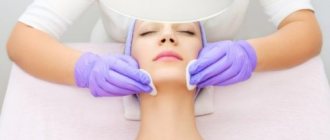Updated: 04/23/2021 11:37:20
Expert: Natalya Borisovna
For decades now, there has been debate about what parabens are, why they are included in cosmetics, and how dangerous they are to human health. Against the backdrop of such consumer interest, some manufacturers are trying to find an alternative to parabens and replace them with other substances with similar properties. Other companies continue to use dubious additives, since most buyers are not at all interested in the composition of cosmetics, and drugs with dangerous compositions continue to be popular. This is also facilitated by the fact that there are no laws that would prohibit the use of parabens in the production of cosmetics. So why do advanced users refuse to purchase drugs that contain potentially dangerous additives? Expertology.ru journalists decided to look into this issue and find out what parabens are in cosmetics, what effect they have, whether these substances are useful or not, and how they are designated in the composition of drugs.
Chemical parabens-preservatives in cosmetics - what are they, list of substances
Having discovered the word “parabens” on the packaging of a cosmetic product, many women put the jar of cream, shampoo or tube of mascara in its place, since this name has already become synonymous with a substance harmful to the body. But is this so, should we be wary of parabens in cosmetics? Experts answer that you should be wary, since parabens are substances of chemical origin, which in itself is bad. However, they have useful properties - they provide protection against the development of fungi and bacteria in cosmetics. Thanks to parabens, cosmetics can be stored longer after the packaging has been opened and its seal has been broken. Due to their beneficial properties, parabens are often used in the manufacture of food and medicine. These substances can also be found in nature, in the chemical composition of some plants. But there are parabens of natural origin, and not those obtained synthetically.
What substances are hidden under the name “parabens”:
- Methyl.
- Methylparaben.
- Butyl.
- I drank it through.
- Isobutyl.
- Isopropyl.
- Benzylparaben.
- Pentylparaben.
- Phenylparaben.
- Sodium salts.
- Isobutylparaben.
A combination of chemicals, which is often combined under the general name “hydroxybenzoic acids” without specifying any details, is metagine, propagine, nipagin, nipazole.
Different cosmetics contain different parabens. It all depends on the reproduction of which groups of bacteria and microbes need to be suppressed. In addition, specific chemicals act differently under certain conditions. Often, in order to enhance the preservative properties of parabens, manufacturers use their combinations.
If you see the names listed below in the list of ingredients of a cosmetic product, it means it contains parabens. They can also be identified by their characteristic alphanumeric designations - E218 and E219 (methylparaben), E214 (ethylparaben), E216 (propylparaben). Or by name in Latin:
- Methylparaben.
- Ethylparaben.
- Isopropylparaben.
- Propylparaben.
- Butylparaben.
- benzylparaben.
- Glutaraldehyde.
- Hexamidine-Diisethionate.
- Phenol.
- Phenyl Mercuric.
- Benzetonium Chloride.
Some not particularly conscientious manufacturers, in order to increase the purchaseability of their own products, indicate in the composition not the name of specific drugs, but the names of mixtures or generally synonymous terms, trade names. And it is not so easy to determine that these mixtures consist of preservative chemicals. Here is an incomplete list of the names of substances under which parabens may be hidden:
- Germanon-K (Phenoxyethanol, Benzyl Alcohol, Methylparaben, Propylparaben, Propylene Glycol).
- Nipagin (Methylparaben).
- Nipazole (Propylparaben).
- Sharomix:
- 300 (Methylparaben, Propylparaben, Bronopol, Phenoxyethanol).
- 331 (Methylparaben, Ethylparaben, Propylparaben).
- 410 (Methylparaben, Ethylparaben, Benzyl Alcohol).
- 431 (Methylparaben, Ethylparaben, Propylparaben, Butylparaben, Isobutyl Paraben).
- 541 (Methylparaben, Ethylparaben, Propylparaben, Butylparaben).
- ME (Methylparaben, Ethylparaben, Phenoxyethanol).
Particularly dangerous are cosmetics whose packaging indicates that these parabens occupy the first place in the list of component composition.
What is food additive E216?
Reference. Propylparaben is an artificial preservative, an antimicrobial reagent of synthetic origin, belongs to the group of parabens.
Possible names of food additive E216:
- para-hydroxybenzoic acid propyl ester;
- propyl para-hydroxybenzoate;
- propyl 4-hydroxybenzoate;
- nipazole;
- propylparaben;
- propyl-p-hydroxybenzoate;
- E-216.
Description and properties
Propylparaben is characterized by the following properties:
| Index | Description |
| Color | White, with a grayish tint |
| Appearance | Fine powder |
| Smell | Not expressed |
| Taste | Absent |
| Compound | C10H12O3 |
| Main functions | Preservative – antimicrobial effect, increasing product shelf life |
| Solubility | In water – weak, in alcohols and alkalis – good |
What and how is it obtained from?
Important. Propylparaben is produced by the esterification of para-hydroxybenzoic acid and propanol (propyl alcohol).
The world's main producers of the E216 additive, supplying it to Russia:
- Fengchen Group Co, Ltd (China);
- Foodchem International Corporation (China).
What are the dangers of chemicals in cosmetics?
Parabens have been widely used in the cosmetics industry for over fifty years. But only in the early 2000s did the feasibility and safety of their use begin to be discussed among scientists and ordinary consumers. Large-scale research into the safety of these substances has begun. As a result, the public has gained access to facts that indicate the potential danger of parabens for the human body, no matter how they penetrate into it - through food or through the skin.
What is the danger of contact with parabens in cosmetics:
- These chemicals have estrogenic effects. That is, they contribute to increased production of female hormones of the estrogen group - estradiol, estriol and estrone. It turns out that using cosmetics that contain parabens is contraindicated for men. As well as some other categories of citizens. For example, people with hormonal imbalances, pregnant women. After all, excess estrogen in the body of the expectant mother can have a negative impact on the health of the fetus, as well as on the future reproductive ability of the woman.
- The accumulation of parabens (and, as a consequence, estrogen) in the body is an increased risk of developing cancer of the human reproductive system. Women are more likely to develop uterine or breast cancer, and men are more likely to develop testicular cancer.
- Parabens in cosmetics increase the negative effects of ultraviolet (sun) rays. For example, you apply moisturizer and sunscreen to your skin, or use a foundation with UV protection. But cosmetics contain parabens. As a result, you not only get the opposite result, but also expose your skin to increased risk. Skin photoaging processes occur faster than usual. In addition, there is a risk of DNA damage, which can result in various mutations in the offspring. To be fair, it should be noted that in order for violations to occur at the genetic level, you need to use cosmetics with parabens for decades and in large quantities.
- Parabens in cosmetics can cause areas of redness and irritation of the skin, especially in people with sensitive skin. In the most severe cases, a non-standard immune response of the body may occur - rashes appear on the surface of the epidermis, tissues swell, itch and itch.
- Parabens used in cosmetics somehow find their way into wastewater. These chemicals pollute the rivers where people get their drinking water. Next, soil contamination occurs, in particular agricultural lands. Due to the high concentration of chemicals in water and soil, they begin to pollute the air we breathe.
Considering the dangers of using parabens, why are these substances not yet banned for use in cosmetics? Firstly, because the dangerous properties of these chemicals have not yet been 100% proven and are not recognized at the official level. Secondly, because the use of parabens has some advantages for both manufacturers and consumers of cosmetics.
What do the studies say?
For about a decade, the debate on assessing the safety of parabens has not subsided. During this time, the size of the doses, which, according to scientists, will not harm us, have been questioned more than once. However, the very fact that these doses have been steadily reduced over the past decade (for example, Propylparaben and Butylparaben are conditionally "safe" at concentrations below 0.19% relative to the 0.4% that was previously effective and considered safe) is at least cause for concern. Think carefully before using exclusively cosmetics that contain them. Most substances are still being assessed and tested by global committees.
Parabens are generally considered safe in minimal doses, and these doses are still being monitored, meaning the safe minimum is constantly changing.
Despite this, the compounds of these substances are included in the list of safe preservatives. Proponents of their use present their arguments, in particular, claiming that there are natural parabens - esters of p-hydroxybenzoic acid, found in nature - in blackberries, raspberries and vanilla. Another undoubted advantage is their wide range of effects.
Useful properties and advantages of parabens in cosmetics, alternative opinions of scientists
Let's look at what arguments there are for the use of parabens in cosmetics:
- Parabens, like sulfates, are the most effective substances that are responsible for the possibility of long-term storage of cosmetics in open form. No manufacturer wants their product to begin to emit an unpleasant odor or change consistency after a few weeks of use. Consumers who spend a lot of money on purchasing cosmetics do not want this either, expecting that the products will retain their original characteristics and qualities for as long as possible. In addition, if consumers knew what, for example, columns of cocci on the skin are fraught with, a new wave would immediately begin with a call to return parabens back to the composition of cosmetics.
- Parabens can stabilize the formula of cosmetic products. Their presence in the composition of the products helps maintain optimal consistency and allows all components to harmoniously combine with each other.
- Parabens are cheap and effective even in small quantities. It is more economical to use only a preservative such as formaldehyde, which was done at the beginning of the industrial production of cosmetics. In addition, parabens have already been well studied, have undergone clinical trials, and also have a fairly long history of safe use, as they are used throughout the world in cosmetic, food and pharmaceutical production. But what side effects can be caused by other preservatives that act as an alternative to parabens is unknown; we will know about this no earlier than in 20-25 years.
- Parabens do exhibit estrogen-like activity, but it is weak enough to cause significant harm to the body of a healthy adult. Independent studies and their results indicate that if the average woman uses cosmetics (shampoos, creams, serums, sprays, deodorants and shower gels) with parabens every day, then the dose of chemicals she receives is approximately 0.1–0. 4 mg/kg/day. This is approximately several thousand times less than what is required for the process of stimulating excess estrogen production to begin. However, there are a large number of much more powerful estrogenic chemicals that consumers encounter almost every day. For example, ethinyl estradiol (found in birth control and cancer drugs) and phytoestrogens (natural compounds found in many foods).
- Independent studies confirm that parabens are generally considered to be relatively safe preservatives, which are essential to any part of the cosmetics industry. These chemicals, penetrating the stratum corneum, are theoretically converted into a non-toxic metabolite by enzymes in the human body. These non-toxic compounds are eliminated from the body naturally very quickly.
- According to representatives of the SCCS (Scientific Committee on Consumer Safety) and the FDA (US Food and Drug Administration), parabens are natural preservatives that normally do not cause allergic reactions.
- Parabens are quickly absorbed by the body, their effects (in the absence of an allergic reaction) are almost invisible. For significant complications or side effects to occur, chemicals must accumulate in the consumer’s body for a sufficiently long time. But parabens do not accumulate; they are metabolized by skin enzymes and then excreted from the body in the urine.
- In 2010, global organizations such as SCCS and the FDA revised the results of recent studies on the safety of the use of parabens in the cosmetic industry. Experts have concluded that parabens are safe if recommended dosages are used, which manufacturers must strictly adhere to. If you use cosmetics from reliable brands, they have the appropriate quality and safety certificates, you do not have to worry that the safe level of preservatives in the preparations is exceeded.
Experts understand that cosmetics containing parabens have almost as many advantages as disadvantages. Therefore, they simply do not recommend using such drugs for a long period of time, but they also do not come out with categorical approvals or prohibitions in the direction of chemical-based products.
What can be replaced?
Attention. Substitutes for propylparaben can be other substances from the group of preservatives and parabens that have similar properties - benzoic acid and its salts E210-213, sorbic acid and its derivatives E200-203.
They have their own characteristics and standards of use, which differ from the characteristics of the E216 additive.
Propylparaben is a synthetic preservative. It is prohibited for use in food products in some countries of the world, including Russia. The safety of its use in cosmetic products for external use is not guaranteed, but has not been refuted by modern scientific research.
If you find an error, please select a piece of text and press Ctrl+Enter.
Cosmetics containing chemical preservatives such as parabens
Parabens, which act as preservatives, are used primarily in the production of cosmetic preparations with a liquid consistency. That is, in those products that contain some amount of liquid - water. Such an environment promotes the growth and activation of colonies of pathogenic microorganisms, and parabens inhibit this process.
Types of cosmetics that contain chemical preservatives:
- Primer,
foundation, fluid. Due to the fact that these cosmetic products contain parabens, they can retain their characteristics and properties for 6-18 months. However, shelf life is affected not only by the concentration of preservatives, but also by the consistency of the products themselves. For example, a thick foundation contains less water than a light and liquid cream fluid. Therefore, foundation will last longer than fluid.
- Mascara.
In the manufacture of this product, preservatives are necessarily used. The mascara wand is constantly in contact with the eyelashes, sometimes it is placed on the table surface, so a large number of pathogenic microorganisms penetrate through it into the tube. The tube creates ideal conditions for the proliferation of bacteria, fungi and microbes. Therefore, despite the presence of parabens, mascara has the shortest service life compared to other cosmetics. It is not recommended to store it longer than 3-6 months after first use.
- Concealer, liquid highlighter, corrector, bronzer
. Even taking into account the presence of preservatives, such cosmetics should not be used longer than six months after the packaging has been opened.
- Cosmetics for lip makeup
– glosses, lipsticks, gels, etc. The situation with these drugs is the same as with concealers. They can be used no longer than six months.
- Creams for face and body skin care
. If you buy cosmetics in a jar and scoop it up with your fingers, you can use the product for 3-4 months.
- Roll-on deodorants, etc.
. Since the product is applied to the skin of the armpits, where bacteria develop very quickly and in large numbers, and the ball is constantly in contact with them, you need to use the deodorant for no longer than 1-2 months. It is better to buy deodorant in a small package so that you can use it before the expiration date. Or use aerosol preparations.
Parabens are also widely used in the production of such cosmetics:
- Shampoos, balms, hair styling and styling products.
- Shower gels and liquid soap.
- Children's cosmetics (however, most types of parabens are prohibited for the production of cosmetics for children under three years of age).
- Toothpaste.
- Wet wipes.
In general, we can say that parabens can be found in 77-85% of wash-off decorative products and in 99% of products that cannot be washed off. Moreover, it does not matter in which country the cosmetic product is produced, preservatives are used everywhere by companies from Europe, America, Asia, as well as Russian manufacturers.
If you are used to using water-based cosmetics, it is better that it contains benzylparabens, propylparabens and methylparabens. These chemicals are characterized by the greatest safety, as well as increased resistance to external influences, including high humidity and air temperature.
The mechanism of action of parabens.
The mechanism of action of parabens is based on the phenomenon of denaturation of microbial proteins and inactivation of enzymes . Parabens damage their cell walls , reducing permeability, disrupting genetic structure, and inactivating enzymes and metabolites necessary for the growth of microorganisms .
How to remove cosmetics with parabens
To reduce the negative impact of parabens on the body, as well as following normal hygiene standards, cosmetics should be washed off the face at least once a day - before going to bed. And here the question arises - how to wash off products that contain preservatives - with drugs that also contain parabens? Experts answer that the best preparation for cleansing the skin of cosmetics is micellar water. The manufacturing features of this product make it possible not to include parabens and sulfates in its composition. The same applies to a large number of hydrophilic oils of different brands.
Purpose of preservatives.
The main purpose of preservatives is to suppress the growth of bacteria, fungi, mold and yeast . This way the service life of this drug . Preservatives also protect against loss of aroma and appropriate consistency of the cosmetic product.
Cosmetics labeled “Paraben Free” – truth or myth
In the wake of general panic about parabens in cosmetics, manufacturers began to find ways to mislead consumers. Therefore, despite the fact that analogues to parabens have not yet been found, on store shelves you can find cosmetics with very tempting icons on the packaging like “Paraben Free” or “without parabens in the composition.”
But is this information true? In the vast majority of cases, no. Manufacturers simply indicate not the original name of paraben chemicals in the composition, but an alternative one, that is, they simply use synonyms. This is the same as calling acetylsalicylic acid aspirin - the meaning is the same, the names are different. For example, you see that the list of ingredients does not indicate that methylparaben is present, but it is indicated that methyl paraoxybenzoate was used in the manufacture of the drug. This means that the “Paraben Free” icon does not provide real information about the composition of the cosmetic product, because it still contains parabens or their substitutes. Some “double” parabens are even more dangerous, as they have carcinogenic and toxic properties.
And yet there are manufacturers of natural beauty products that use truly natural substances as preservatives. These can be vitamins C and E. Or oils with antiseptic properties - tea tree or eucalyptus oil, almond, olive, lavender, jojoba, argan and lavender, as well as substances such as natural propolis, grapefruit seed extract, etc.
Our experts provided information about several brands that offer cosmetics with almost 100% safe ingredients:
- Natura Siberica
. This is one of the most reliable and respected domestic brands producing paraben-free cosmetics. Hair masks, shampoos, gels and creams for the face and body - all these products are 95% natural substances. The presence of parabens in these products was not detected.
- LOGONA
. This is a German company that produces hypoallergenic bio-cosmetics. The brand's products do not contain chemical preservatives and are designed for consumers with very sensitive skin prone to allergies.
- REN
. A world-famous British brand whose products do not contain synthetic components such as petroleum products, synthetic dyes and fragrances, and parabens. The cosmetics of this company have passed clinical trials and are approved by dermatologists.
- Dr. Hauschka.
The products of this brand occupy leading positions in the ratings of Paraben Free cosmetics. The product range of this company includes different types of cosmetic and hygiene products - shampoos, creams, toothpastes, antiperspirants, decorative cosmetics, etc.
We also list the most popular paraben-free shampoos among consumers:
- Neutral shampoo for sensitive skin from Natura Siberica.
- Shampoo Color and Volume Without Silicone from SYOSS.
- Tea Tree Triple Treat Shampoo by Giovanni.
- Organic Raw Shea Butter Moisture Retention Shampoo by Shea Moisture.
- Naturia Dry Shampoo by Rene Furterer.
- Tea Tree Tingle Shampoo from Trader Joe's.
How to reduce the likelihood of negative action
You can use cosmetics with parabens; if used wisely, they are safe. There are a few simple rules:
- simultaneously use no more than 1-2 products containing these preservatives;
- add natural ingredients or eco-cosmetics to your care procedures;
- immediately stop using the product if it causes any undesirable reactions;
- When purchasing a new brand of cosmetics, you should start using it gradually to make sure that your skin reacts normally;
- carefully study the composition before purchasing, know the designation of parabens in cosmetics.
How are parabens designated?
- ethylparaben: Ethylparaben;
- propylparaben: Propylparaben;
- methylparaben: Methylparaben.
For simplicity, you can remember that these substances include those labeled as E214 - E219.
Also, names can be replaced by chemical terms that are similar in meaning:
- propagine or metagin;
- hydroxybenzoate or oxybenzoate;
- hydroxybenzoic or hydroxybenzoic acids, their esters or salts;
It is worth considering that the manufacturer is obliged to indicate chemical components on the packaging only if their content exceeds 1%. Since the concentration of parabens is usually much lower, these substances may not be listed in the composition at all.
Organic or green cosmetics without parabens - truth or myth
Parabens and the potential harm they can cause to the skin or the body as a whole have so frightened the modern consumer that some women have begun to prefer so-called organic cosmetics. But few of them understand that drugs supposedly of organic origin are not much better than conventional products. After all, in any cosmetics that you can buy in a store, which is produced not in limited quantities, but on an industrial scale, parabens are present. And if the packaging states that it is “organic” or “natural” cosmetics, this just means that it contains fewer preservative chemicals than other products. But there are parabens there, even in minimal quantities. The disadvantage of such cosmetics is that the consumer is deceived or misled. The advantage is that such drugs are still safer for health and can act as an excellent alternative to products in which parabens occupy a leading position.
Recently, the market’s response to the active actions of various public organizations that demand the elimination of parabens from cosmetics has been the start of the production of self-preserving products that do not contain preservatives. But all this is at the stage of development and clinical trials; such cosmetics cannot yet be found in stores. Therefore, marketers launched a product similar to organic cosmetics - green cosmetics, in which parabens were replaced with so-called natural preservatives - essential oils and organic acids with antibacterial properties. However, how well these substances protect cosmetics from the proliferation of pathogenic microflora is not known, and their side effects have not been fully studied. The main reason parabens are so popular is that they show excellent levels of effectiveness even at low concentrations. And natural preservatives are much less effective. So “green”, organic cosmetics will either have a short shelf life or contain a large amount of natural preservatives. At the same time, essential oils and organic acids are strong allergens, the presence of which in cosmetics increases the risk of an undesirable reaction to a particular product several times. It turns out that using drugs with parabens is not much more dangerous than using organic or green cosmetics.
If you are afraid of parabens
If you are not convinced by the research data and you still fear for your health, read the list of ingredients on the packaging of the cosmetic product and choose one that contains paraben with the lowest hazard class.
Table: list of parabens used in cosmetics
| Paraben | EWG SkinDeep hazard rating out of 10 points |
| methylparaben (E218) | 4 |
| ethylparaben (E214) | 4 |
| propylparaben (E216) | 5 |
| butylparaben | 7 |
| benzylparaben | 2 |
| isobutylparaben | 7 |
| isopropylparaben | 7 |
You can minimize possible harm by following several rules:
- do not leave makeup on your face overnight;
- do not use sunscreens with methylparaben;
- stop using the product if you experience side effects;
- pre-test cosmetics if they contain parabens that are new to you.
Paraben should be last on the ingredient list. Do not buy a product if the preservative is not at the end, but at the beginning or middle of the list; its concentration may exceed the permissible level.
Alternative drugs without parabens
There is an alternative to cosmetics with parabens, or rather, there are three options for replacing potentially dangerous cosmetics:
- Homemade cosmetics. Soaps, creams, tonics, eye shadows and similar care or decorative cosmetics can be made with your own hands. And for this purpose, use exclusively natural, safe ingredients that will not cause the slightest harm to the skin or other organs. For example, to make a moisturizer, you can use lanolin, glycerin and vegetable oils (as a base), mineral water, herbal decoctions and freshly squeezed juices, essential oils, liquid vitamins, etc. Such cosmetics will be stored for a short time and only in the refrigerator, but you will be sure that skin care products bring only benefits, their use will not cause incurable diseases in you or your children.
- Purchased handmade cosmetics. This option will be ideal for those who do not have time to prepare the preparations themselves. Private masters value their reputation and use only high-quality ingredients, the safety of which has been proven by clinical studies.
- Purchased cosmetics from large cosmetic brands that have the opportunity to introduce innovative technologies into their own production and allocate significant investments for this. Such drugs will be expensive, they can be stored for a short time, only two or three weeks, but you will have peace of mind about your health.
- Waterless cosmetics. If you use products that do not contain water, then you do not have to worry about the fact that they will contain parabens. Anhydrous products technically do not require a preservative. After all, in order to grow and reproduce, pathogenic microflora require water. However, such cosmetics must be stored and used in a completely dry room. After all, anhydrous preparations cannot retain their original characteristics for a long time if they are used in humid conditions.
As you can see, there is an alternative to cosmetics with parabens. If the issue of safety of care and decorative products is important to you, take a step away from traditional cosmetics and discover natural cosmetics for face and body.
Is it prohibited for use in Russia and other countries?
On the territory of the Russian Federation, the E216 additive was excluded from the list of substances permitted for use in food production in 2008 (according to Resolution of the Chief State Doctor of the Russian Federation dated May 26, 2008 No. 32).
It was previously used as a preservative along with other parabens as an antibacterial component in food products. It is approved in Russian industry for the manufacture of cosmetic and pharmaceutical products for external use.
In the countries of the European Union, Belarus and Ukraine, propylparaben is also prohibited for use in food production. In the USA, Canada and Japan, the E216 additive is approved for the manufacture of food and medicinal and cosmetic products.
Parabens and hormones
Parabens are credited with a so-called estrogenic effect. Its action is very similar to how estrogen behaves in the body in the form of estradiol, the female sex hormone. It is believed that parabens can affect the early maturation of girls and negatively affect male fertility, and in extreme situations even cause their feminization.
There is research that, due to small but powerful effects, the estrogenic effect of these substances can lead to hormonal imbalance. However, after careful analysis, we come to the conclusion that this does not necessarily mean a real threat. It all depends on how the paraben affects specific estrogen receptors and the amount of the substance that enters our body.
Pure estradiol truly has a profound effect on the functioning of the human body. It has been proven, however, that when it comes to the estrogenic effects of parabens, this effect is 1000 to 100,000 times weaker! Therefore, it is quite unlikely that the use of cosmetics containing parabens can cause serious disorders, but scientists still have such concerns.
How to read a label
Source here and below : Pexels
The names of components in cosmetics are usually written according to the INCI standard (International Nomenclature of Cosmetic Ingredients). They are officially fixed at the legislative level of most countries.
According to the rules, manufacturers must reflect absolutely all components in the composition, listing them in decreasing order, according to concentration. Substances that make up less than one percent of the content need not be mentioned. At the same time, preservatives and flavorings are usually last on the list. Organic ingredients in manufacturers' formulations are usually marked with an asterisk.
